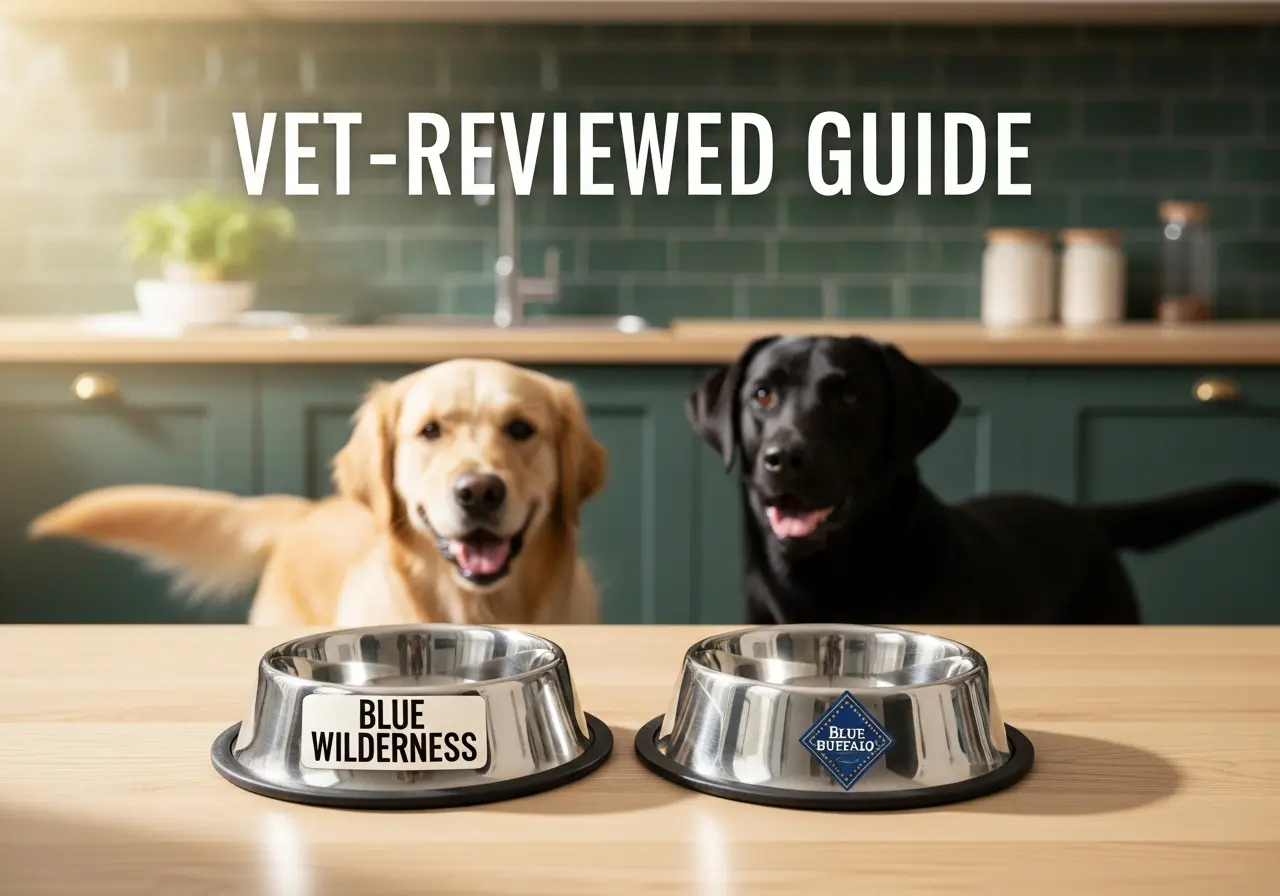Strolling down the pet food aisle can feel overwhelming. You see multiple bags with the familiar “Blue” logo, yet they promise different things. One says “Wilderness,” and the other says “Life Protection.” You wonder, “Aren’t they from the same company? What’s the real difference?”
If this sounds familiar, you’re not alone. Both Blue Wilderness and Blue Buffalo Life Protection are premium dog foods made by the same respected brand, Blue Buffalo. However, they are formulated for very different canine needs, lifestyles, and even your budget. Choosing the wrong one could mean feeding your couch-potato Corgi a diet meant for a sled dog.
This vet-reviewed guide breaks down everything you need to know. We’ll compare ingredients, nutritional value, and safety records to help you confidently decide which formula is the perfect fit for your furry family member.
What’s the Difference Between Blue Buffalo and Blue Wilderness?
Understanding the distinction starts with the brand’s core philosophy. Blue Buffalo was founded in 2003 with a mission to create pet food with high-quality, natural ingredients. It has since grown into a major player in the premium pet food market and was acquired by General Mills in 2018.
The brand offers several product lines, but two of its most popular are Life Protection and Wilderness.
- Blue Buffalo Life Protection: This is the brand’s flagship line. It’s designed to provide balanced, everyday nutrition for family pets. It’s a grain-inclusive formula that supports overall health without the ultra-high protein levels of more specialized diets.
- Blue Wilderness: This sub-brand was created to mimic the diet of a wolf, with a focus on high-protein, grain-free recipes. It’s aimed at active dogs, dogs with grain sensitivities, or owners who prefer a diet rich in meat.
Think of it this way: Life Protection is for the well-rounded family companion, while Wilderness is for the high-performance canine athlete.
Is Blue Wilderness Better Than Blue Buffalo? An Ingredient Showdown
“Better” is subjective; the right choice depends entirely on your dog’s individual needs. A quick look at a typical adult chicken recipe from each line reveals their core differences.
Feature | Blue Buffalo Life Protection | Blue Wilderness |
|---|---|---|
Guaranteed Protein | 24% | 34% |
Guaranteed Fat | 14% | 17% |
Grain-Free | ❌ (Contains brown rice, barley) | ✅ |
Primary Meat Source | Deboned Chicken | Deboned Chicken |
Calories (Approx.) | ~380 kcal/cup | ~410 kcal/cup |
Ideal Dog Type | Indoor, family, less active dogs | Active, working, grain-sensitive dogs |
The most significant differences are protein content and the inclusion of grains. Blue Wilderness boasts a massive 34% protein, which is ideal for supporting lean muscle mass in highly active or working dogs. In contrast, Life Protection’s 24% protein is more than adequate for the average adult dog that spends its days walking, playing, and napping.
Both formulas contain Blue Buffalo’s signature “LifeSource Bits.” These are small, dark kibbles mixed in with the regular food, containing a precise blend of antioxidants, vitamins, and minerals selected by holistic veterinarians and animal nutritionists to support immune system health.
💡 Tip: Higher protein isn’t always better. Excess protein is converted into fat or excreted, which can put unnecessary strain on your dog’s kidneys, especially in older pets. Always match the protein level to your dog’s activity level, not just what sounds healthiest.
A Note on Grain-Free vs. Grain-Inclusive Diets
The grain-free nature of Blue Wilderness is a major selling point for many owners. However, the debate around grains is complex. While some dogs have genuine sensitivities to grains like corn or wheat, healthy grains like brown rice and barley (found in Life Protection) are excellent sources of fiber, carbohydrates for energy, and essential nutrients.
In 2018, the FDA announced it was investigating a potential link between certain grain-free diets and a heart condition called dilated cardiomyopathy (DCM) in dogs. While no definitive cause has been established, the focus has been on diets high in legumes like peas and lentils. This makes it crucial to discuss any diet change with your veterinarian.
How Safe is Blue Buffalo? A Look at Recall History
Transparency about a brand’s safety record is important. Blue Buffalo has faced several recalls between 2007 and 2017 for issues ranging from excess vitamin D to potential salmonella contamination. This history is something to be aware of.
However, since its acquisition by General Mills in 2018, the company has invested heavily in improving its quality control and food safety protocols. There have been no major recalls in recent years, suggesting these enhancements have been effective.
🦴 Vet Note: Regardless of the brand, always purchase dog food from trusted, authorized U.S. retailers like Chewy, PetSmart, or your local pet store. This helps ensure the food is authentic and has been stored and handled properly, reducing the risk of contamination.
Real-World Use Cases and Veterinarian Insights
So, how do these formulas perform in the real world? The best choice often comes down to your dog’s age, breed, and energy output.
For a senior Golden Retriever who enjoys leisurely walks and long naps, the high-protein, high-calorie Blue Wilderness formula would likely be too rich. It could lead to weight gain and place undue stress on aging kidneys. The moderate protein and balanced nutrition of Blue Buffalo Life Protection would be a much better fit for maintaining health in his golden years.
Conversely, a young, energetic Border Collie who spends weekends hiking or training for agility would thrive on Blue Wilderness. The 34% protein would help build and repair muscle tissue, and the higher fat content would provide sustained energy for her demanding activities.
Dr. Sarah Wooten, DVM, a respected veterinarian, notes, “Grain-free diets suit some dogs, but most thrive on moderate protein and balanced carbs from sources like whole grains. The key is tailoring nutrition to the individual dog, not chasing trends.”
⚠️ Warning: A high-protein diet may strain the kidneys of senior dogs or those with pre-existing kidney conditions. Always consult your vet before switching an older dog to a high-protein formula.
💡 Tip: When switching your dog to a new food, do it slowly to avoid digestive upset. Mix 25% of the new food with 75% of the old food for a few days, then gradually increase the new food over 7-10 days until you’ve fully transitioned.
Our Top Product Recommendations
TailWaves may earn a small commission from qualifying purchases—at no extra cost to you. We only recommend products we stand behind.
Best for Most Adult Dogs: Blue Buffalo Life Protection Formula

Blue Buffalo Life Protection Adult Chicken & Brown Rice Recipe is our top pick for the average family dog. It delivers balanced nutrition from quality ingredients without the extreme protein levels that most pets simply don’t need.
- Pros: Made with real deboned chicken, includes wholesome grains for digestion, and is fortified with LifeSource Bits for immune support.
- Cons: Not suitable for dogs with diagnosed grain allergies.
- Best For: Adult dogs of all breeds needing a reliable, balanced diet for everyday health.
Best for Active Dogs: Blue Wilderness High Protein Formula

For the canine athlete in your life, Blue Wilderness High Protein Grain-Free Chicken Recipe is an excellent choice. Its protein-packed formula is designed to fuel an active lifestyle and support strong, lean muscles.
- Pros: A high 34% protein content, grain-free for sensitive dogs, and includes omega fatty acids for skin and coat health.
- Cons: Higher price point and may be too rich for sedentary dogs.
- Best For: Active or working dogs, dogs with high energy needs, or those on a vet-approved grain-free diet.
Best for Dogs with Poultry Allergies: Blue Wilderness Red Meat Formula

If your dog is sensitive to chicken, the Blue Wilderness Rocky Mountain Recipe with Red Meat offers a fantastic alternative. It uses deboned beef as its primary protein source, providing a high-protein, grain-free option that’s easy on the digestive system.
- Pros: Poultry-free recipe featuring deboned beef, venison, and lamb. Grain-free and packed with nutrients for peak performance.
- Cons: Specialist ingredients come with a premium price tag.
- Best For: Active dogs with poultry allergies or sensitivities.
Quick-Look Comparison
Formula | Protein | Grain-Free | Price Guide | Ideal For |
|---|---|---|---|---|
Life Protection | 24% | No | $$ | Family dogs, seniors |
Wilderness Chicken | 34% | Yes | $$$ | Active dogs |
Wilderness Red Meat | 30% | Yes | $$$ | Dogs with poultry allergies |
The Verdict: Choose Blue Buffalo Life Protection for balanced, budget-friendly nutrition suitable for the vast majority of adult dogs. Choose Blue Wilderness for its grain-free, high-protein formula if you have an athletic, working dog or one with specific dietary needs confirmed by a vet.
Frequently Asked Questions
Is Blue Wilderness the same as Blue Buffalo?
No, but they are related. Blue Wilderness is a specific product line made by the parent company, Blue Buffalo. Think of Blue Buffalo as the main brand and Blue Wilderness as its high-protein, “ancestral diet” sub-brand.
Which Blue Buffalo formula is better for puppies or seniors?
For most puppies, the **Blue Buffalo Life Protection Puppy** formula provides the balanced nutrients needed for healthy growth. For seniors, the **Life Protection Senior** recipe is often a better choice, as its moderate protein and controlled calorie levels help maintain a healthy weight and support aging joints without over-taxing the kidneys.
Why is Blue Wilderness more expensive than Blue Buffalo Life Protection?
Blue Wilderness typically costs more due to its higher meat content. High-quality animal protein is more expensive than the grains and vegetables it replaces. The specialized, grain-free formulation also contributes to its premium price point.
Is grain-free dog food bad for dogs?
Not necessarily, but caution is advised. While great for dogs with true grain allergies, the FDA has investigated a potential link between some grain-free diets (especially those high in legumes) and the heart condition DCM. Most dogs digest healthy grains well. Always consult your veterinarian to determine if a grain-free diet is appropriate for your specific dog.
Which formula has fewer recalls?
Both lines fall under the Blue Buffalo brand, so they share the same recall history. The brand had several recalls prior to 2017 but has significantly improved its safety standards since being acquired by General Mills, with no major recalls in recent years.
The Final Paw-sition
Both Blue Buffalo Life Protection and Blue Wilderness are premium dog foods that offer excellent nutrition. They aren’t competitors—they are two different tools for two different jobs. The best choice is the one that aligns with your dog’s unique activity level, age, health needs, and your family’s budget.
Life Protection is a fantastic, reliable choice for the everyday companion, while Wilderness is a high-performance fuel for the canine athlete. By looking past the marketing and focusing on your dog’s individual requirements, you can make a choice that supports a long, happy, and healthy life.
To compare premium diets, see our Blue Buffalo vs Royal Canin guide. It highlights key differences between natural and veterinary formulas.









